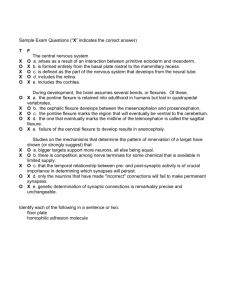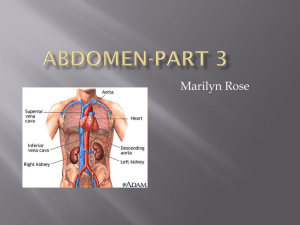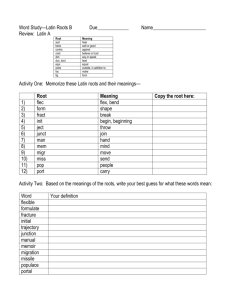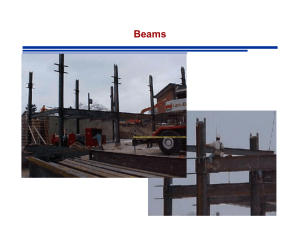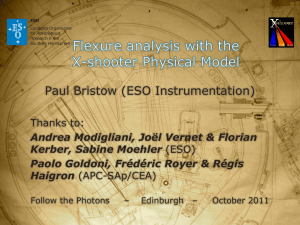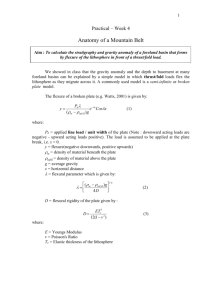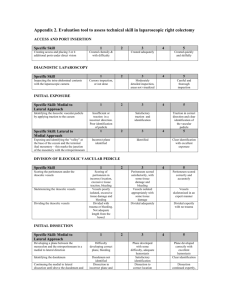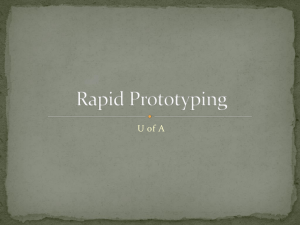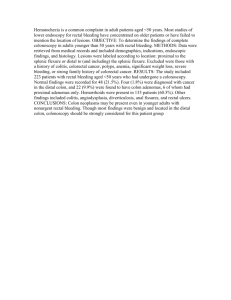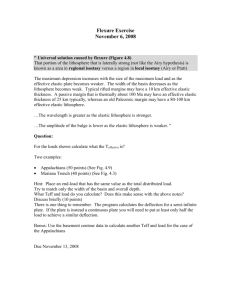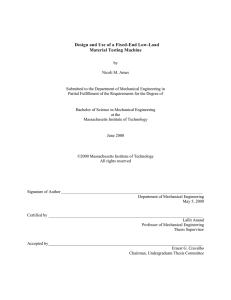Flexure Design - The University of Arizona College of Optical Sciences
advertisement
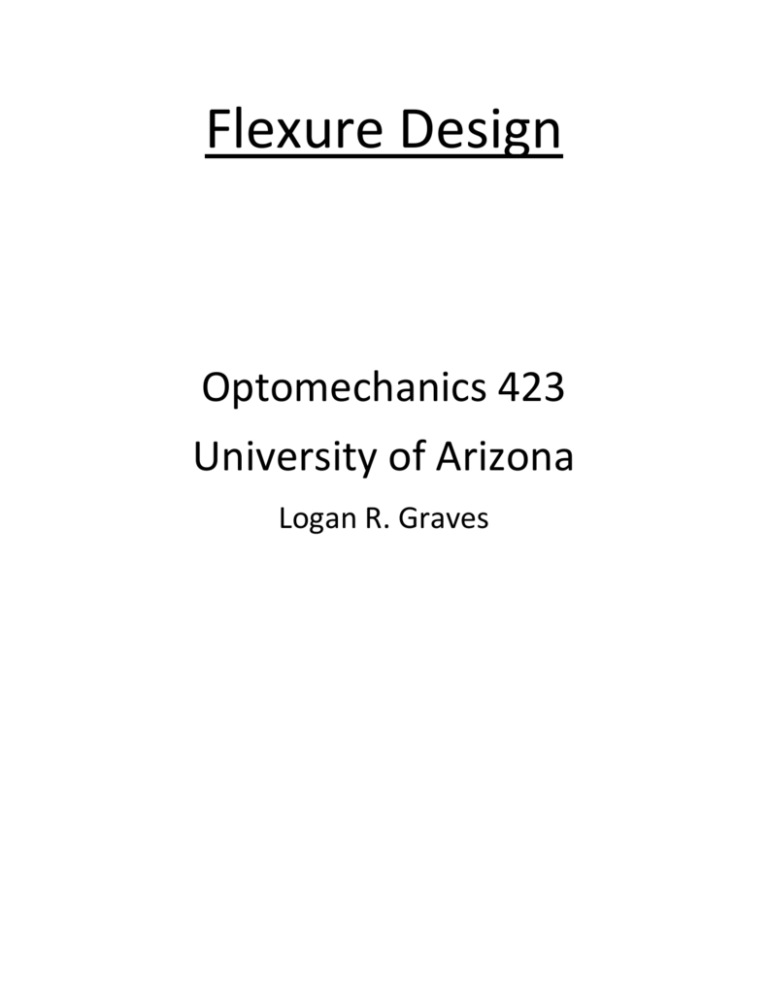
Flexure Design Optomechanics 423 University of Arizona Logan R. Graves Design The goal of this project was to design a flexure which would fit inside of a 4”x4”x1” container. This flexure was to be crafted using a 3D printer, and thus the assumption was made that the flexure was being crafted out of ABS plastic, a common 3D printer material. The job this flexure was envisioned completing is securing an optical component which needs very fine lateral translation to a fixed stage. A figure is shown below demonstrating the concept of the flexure. The design involves four through holes for securing the device to a table. The optical component which needs fine lateral motion is attached to the tapped hole in the top of the flexure. A screw is then threaded in through the bottom of the flexure, and can be threaded to provide fine lateral motion of the optical component. Calculations To design this flexure preliminary hand calculations were made to determine the estimated stiffness and behavior of the flexure. For a double bladed flexure there are simple equations which can be used to calculate the stiffness of the material. From this the deflection based on an expected force can be calculated. Material Properties Young’s Modulus d b t L 2 GPa 1.9 “ 0.25 “ 0.1” 0.45 “ 𝐸 ∗ 𝑏 ∗ 𝑡 ∗ 𝑑2 𝑙𝑏𝑓 𝑁 𝑘𝜃 = ; 𝑘𝜃 = 2.9 ∗ 104 = 5.078 ∗ 106 2∗𝐿 𝑖𝑛 𝑚 𝑘𝑥 = 2∗𝐸∗𝑏∗𝑡 𝑙𝑏𝑓 𝑁 ; 𝑘𝑥 = 3.2 ∗ 104 = 5.604 ∗ 106 𝐿 𝑖𝑛 𝑚 𝑡 3 𝑙𝑏𝑓 𝑁 𝑘𝑦 = 2 ∗ 𝐸 ∗ 𝑏 ∗ ( ) ; 𝑘𝑦 = 1591 = 2.78 ∗ 105 𝐿 𝑖𝑛 𝑚 Based on this data it is clear that the y spring constant is over and order of magnitude smaller than the angular and x spring constants, which is ideal. We can expect a force of 10 N to be applied to the flexure with the screw drive method. Thus, the expected deflection in the y direction is calculated as shown. 𝛿𝑦 = 𝐹 10𝑁 = = 35.8 𝑚𝑖𝑐𝑟𝑜𝑛𝑠 𝑘𝑦 (2.78 ∗ 105 𝑁 ) 𝑚 This is a very fine lateral motion and would be ideal for very fine lateral adjustment to optical components using a fairly average force. Thus, based on the calculations the design can be considered to be sufficient for the desired job. From here a solidworks model was created and FEA was done to verify the design. Solidworks Model A model of the flexure was created using solidworks and the performance of the flexure was analyzed using FEA. A fine mesh was used to model the flexure, as with too large of a mesh there was a nonlinear modeling of the corners of the flexure. It was found that as the mesh fineness increased the stiffness in the y direction of the flexure increased, as the modeling became more accurate. Range of Motion in Y Direction Using FEA in solidworks the range of motion with three different forces applied to the flexure were analyzed. The table below shows the maximum y travel of the flexure for each force applied. Further the output for a 10 N force is shown below as well. Force (N) 1 10 50 Figure 2.1, Displacement with 10 N applied Travel (microns) 7.93 79.35 349.2 Stress and Strain Next the stress and strain applied to the flexure was analyzed, again at 1, 10, and 50 N of applied force. This was done to assure that no uncharacteristic behavior was occurring with the flexure or with the FEA. Only the stress and strain for the maximum force, 50 N, is shown. Figure 3.1, Stress with 50 N Applied Figure 3.2, Strain with 50 N Applied As can be seen with a maximum of 50 N applied there is no unreasonable stress or strain on flexure. However, at this point it must be determined what the yield strength of the flexure is. Originally it was expected that 10 N would be applied using a screw driven method. Therefore, it would be ideal to have a yield strength at least double that force. To determine this a FEA was done using a yield of 60.2 MPa. This corresponded to a maximum applied force of 44 N before exceeding the yield strength of the flexure. This is shown below. Figure 4.1, Yield Force Frequency Analysis A simple frequency analysis was run on the solidworks model to determine the first 4 modes for the flexure. There are listed below along with the outputs from the FEA. Table 5.1, Frequency Analysis Mode 1 2 3 4 Frequency (Hz) 962 1156 2119 2599 Figure 5.1, Frequency 1 Figure 5.3, Frequency 3 Figure 5.2, Frequency 2 Figure 5.4, Frequency 4 The primary modes that are of interest are modes 1 and 2. These correspond to a y lateral force and a shearing force in the x direction. Their frequency is relatively high however and should not be an issue for the flexure. Buckling Analysis The most likely method of buckling for this flexure design would be a twist to the side. A buckling analysis was done in solidworks, and is shown below. As can be seen there is a load factor of 35 before buckling occurs, which seems perhaps excessively high for the model. However, the FEA was run multiple times and that seems to be the load factor for buckling. Detailed Drawings
